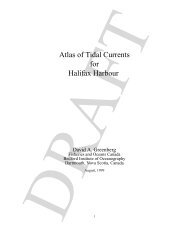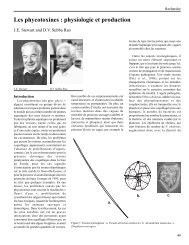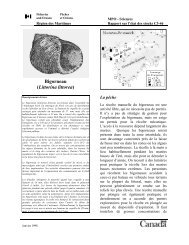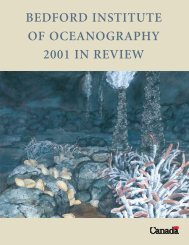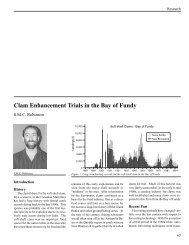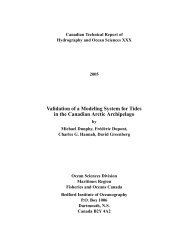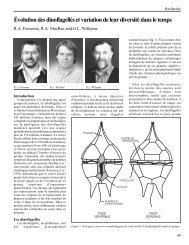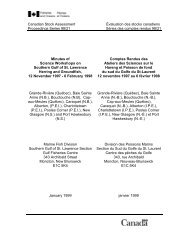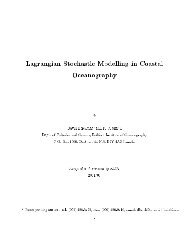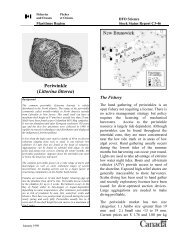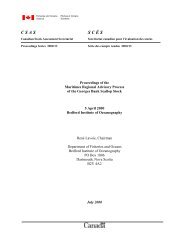Southern Gulf Stimpson's Surf Clam The Fishery - Région des ...
Southern Gulf Stimpson's Surf Clam The Fishery - Région des ...
Southern Gulf Stimpson's Surf Clam The Fishery - Région des ...
Create successful ePaper yourself
Turn your PDF publications into a flip-book with our unique Google optimized e-Paper software.
Maritimes Region<br />
DFO Atlantic Fisheries<br />
Stock Status Report 96/103E<br />
QUEBEC<br />
2<br />
3<br />
4<br />
1<br />
NEW<br />
BRUNSWICK<br />
6<br />
5<br />
<strong>Southern</strong> <strong>Gulf</strong> Stimpson’s <strong>Surf</strong> <strong>Clam</strong><br />
Background<br />
<strong>The</strong> Stimpson’s surf clam is a deep water bivalve mollusc that<br />
can be found in the northern North Pacific and the<br />
northwestern North Atlantic oceans. This mollusc has a<br />
relatively slow growth rate and has a life span of 30 to 40<br />
years.<br />
<strong>The</strong> distribution of the Stimpson’s surf clam is restricted to<br />
benthic substrates with medium to large grain sediments and<br />
where water temperatures are less than 15 o C. In the <strong>Gulf</strong> of<br />
St. Lawrence, the major beds have only been located since<br />
1990 and are found on the northeastern coast of the Magdalen<br />
Islands and the lower north shore of Québec. <strong>The</strong> 1990/91<br />
exploratory fishery from two N.B. fishers showed that various<br />
concentrations of Stimpson’s surf clams were present<br />
throughout the lower north shore of Quebec, on the eastern<br />
coast of Magdalen Islands, the north shore of Miscou Island,<br />
the Gaspé coast, the western coast of Cape-Breton and the<br />
northern coast of PEI.<br />
<strong>The</strong> Stimpson’s clam fishery in the southern <strong>Gulf</strong> started in<br />
1990 with two exploratory or developmental permits. Several<br />
beds were located during the 1990/91 exploratory activities, of<br />
which four beds were selected on the basis of clam density and<br />
data availability to conduct a developmental fishery over the<br />
next 3-4 years. Since then, only one new high concentration<br />
was located in the Baie Comeau area.<br />
<strong>The</strong> experimental sites were evaluated in 1992 and preliminary<br />
quotas were established for each of these beds in the zones<br />
identified on the map. <strong>The</strong> objective of the experimental<br />
fishery was to collect information on fishing activities over a 3-<br />
4 year period to monitor the impact of fishing pressure on the<br />
population.<br />
<strong>The</strong> number of participants in this fishery has gone from 2 in<br />
1990 to over 12 in 1995.<br />
In 1995, the TAC for the <strong>Gulf</strong> of St.-Lawrence Stimpson’s surf<br />
clam fishery was set at 898 mt, with 295 mt for N.B. fishers<br />
and 602 mt for the Quebec fishers. <strong>The</strong> fishing activities are no<br />
longer restricted to the 4 experimental sites and have since<br />
been distributed in 6 fishing zones.<br />
<strong>The</strong> <strong>Fishery</strong><br />
Management: <strong>The</strong> <strong>Gulf</strong> Stimpson’s surf clam<br />
fishery is still in its developmental phase and is<br />
mainly managed as a limited entry fishery with a<br />
TAC established for each of the zones. In 1992, 4<br />
zones (Miscou, Magdalen, Natashquan, Sheldrake)<br />
were established for the 4 experimental fishing sites<br />
for which a biomass had been estimated. In 1995, two<br />
additional zones were added in the St. Lawrence<br />
Estuary while others were subdivided for<br />
management reasons. <strong>The</strong> fishing zones created were<br />
for management purposes only and not based on<br />
biological rationale.<br />
Landings: <strong>The</strong> landing data for the <strong>Gulf</strong> Stimpson’s<br />
clam fishery have fluctuated greatly over its 4 year<br />
history and probably due to markets. In NB, the<br />
landings during the first two years increased during<br />
the initial developmental phase of the fishery and the<br />
marketing activity. <strong>The</strong>re was no active fishing in<br />
1993 due to difficulties in securing a reliable market<br />
for the product but the situation was subsequently<br />
corrected in 1994.<br />
Available from: Maritimes Regional Advisory Process, Department of Fisheries and Oceans, P.O. Box 1006, Stn<br />
B105, Dartmouth, Nova Scotia, Canada B2Y 4A2. Telephone: 902-426-8487. E-mail: d_ged<strong>des</strong>@bionet.bio.dfo.ca<br />
On peut se procurer une version française de ce rapport à l’adresse ci-<strong>des</strong>sus. October 1996
Maritimes Region<br />
<strong>Southern</strong> <strong>Gulf</strong> Stimpson’s <strong>Surf</strong> <strong>Clam</strong><br />
Stimpson’s surf clam TAC and landings (mt) by<br />
fishing zones: 1 Haute Cote Nord, 2 Pointe-<strong>des</strong>-<br />
Monts, 3 Sheldrake, 4 Natashquan, 5 Magdalen, 6<br />
Miscou.<br />
NB<br />
Québec<br />
ZONE 93 94 95 93 94 95<br />
1 TAC 113<br />
Catch 3<br />
2 TAC 23<br />
Catch 0<br />
3 TAC 30 30 30 68 91 91<br />
Catch 0 32 0 NA NA 85<br />
4 TAC 136 182 182 170 284 284<br />
Catch 0 168 0 NA NA 102<br />
5 TAC 68 68 68 136 136 227<br />
Catch 0 55 4 NA NA 55<br />
6 TAC 15 15 15 0 0 0<br />
Catch 0 13 1 NA NA 0<br />
Total TAC 249 295 295 374 511 602<br />
Catch 0 268 5 NA NA 242<br />
Stimpson’s surf clam landings (mt and $) for the NB fishery.<br />
300<br />
250<br />
200<br />
150<br />
100<br />
50<br />
0<br />
LANDINGS (mt) VALUES ($1000)<br />
N.B. Landings (t)<br />
N.B. Landings ($)<br />
1985 1986 1987 1988 1989 1990 1991 1992 1993 1994 1995*<br />
YEAR<br />
Biological data: Data collected from the four<br />
experimental sites in 1991 revealed that the average<br />
size of Stimpson’s clam harvested ranged from 89<br />
mm to 104 mm corresponding to an age range of<br />
between 28 and 40 years old.<br />
<strong>The</strong> fishing gear used in this fishery is the New-<br />
England hydraulic dredge which has an efficiency of<br />
over 90%. Mortality due to damage of non-harvested<br />
clams is evaluated at more than 67% (Lambert and<br />
Goudreau, 1995).<br />
160<br />
140<br />
120<br />
100<br />
80<br />
60<br />
40<br />
20<br />
0<br />
2<br />
Resource Status<br />
Survey estimates of biomasses for the 6 zones were<br />
used to establish TAC’s. <strong>The</strong> first TAC was set in<br />
1992 at 633 t or 1.7% of the total fishable biomass<br />
estimated from the four experimental sites (Giguere<br />
& Landry 1992, Landry et al., 1992). In 1994, the<br />
biomass from the Rocher aux Oiseaux bed was<br />
estimated at 2 098 mt, and, since then, 4 additional<br />
beds have been estimated to bring the total fishable<br />
estimated biomass for the <strong>Gulf</strong> of St. Lawrence at<br />
approximately 50 000 mt. <strong>The</strong> biomass estimates for<br />
this fishery were obtained from geostatistical analysis<br />
with relatively high confidence intervals mainly due<br />
to the patchy distribution of this species as are most<br />
endobenthic molluscan species.<br />
Catch rates: CPUE data from the two expeditions in<br />
1995 are 136 kg/set in zone 6 (Miscou) and 183<br />
kg/set in zone 5 (Magdalen Island). <strong>The</strong> catch rates<br />
vary considerably from those observed in 1994 with<br />
averages of 76 kg/set in Miscou (6), 441 kg/set in<br />
Magdalen Island (5), 198 kg/set in Rocher aux<br />
Oiseaux (5), 257 kg/set in Natashquan, 271 kg/set in<br />
Sheldrake (3) and 391 kg/set in Mingan (3).<br />
Outlook<br />
Projection: <strong>The</strong> current TAC for the two NB license<br />
holders is set at 295 t which account for 33% of the<br />
total TAC for the <strong>Gulf</strong> of St. Lawrence. Based on the<br />
present estimated biomass and exploitation levels, the<br />
TAC should remain at its 1995 level.<br />
Given the slow growth of the animal, we propose a<br />
new management approach with protection for the<br />
broodstock in high density areas. <strong>The</strong> <strong>Gulf</strong><br />
Stimpson’s surf clam fishery is only in its fifth year<br />
and has already gone through several management<br />
changes. One of the major considerations that should<br />
be evaluated for the management of this fishery is the<br />
possibility of establishing a rotational harvesting<br />
system. This system would probably have a positive<br />
effect on the recruitment rate and population<br />
dynamics. It could also be beneficial in reducing the<br />
potential of tainted catches resulting from<br />
inadvertently retrieving moribund clams from areas<br />
recovering from recent harvesting activities.<br />
Management considerations:<br />
Is there a potential to expand this fishery? <strong>The</strong><br />
initial survey of 1990-91 covered most of the <strong>Gulf</strong> of<br />
St. Lawrence including the coasts of the four Atlantic<br />
provinces and Quebec. Biomass estimates from the<br />
data collected were only estimated for the four largest<br />
concentrations (beds) which were deemed
Maritimes Region<br />
commercially viable. Only one new concentration in<br />
the St. Lawrence estuary has been located since the<br />
1990-91 survey. Consequently, it would not be<br />
advisable to expand the present fishing effort.<br />
<strong>Southern</strong> <strong>Gulf</strong> Stimpson’s <strong>Surf</strong> <strong>Clam</strong><br />
polynyma for the 1986 to 1989 period. CAFSAC<br />
Res. Doc. 90/14. 27p.<br />
<strong>The</strong>re are smaller concentrations of Stimpson’s clams<br />
on the northern coast of PEI and the western coast of<br />
Cape Breton, NS which could be considered for a<br />
small inshore fishery to complement the traditional<br />
bar clam (Spisula solidissima) fishery.<br />
Are surf clams part of the food chain? Yes,<br />
according to Waiwood (unpublished data), surf clams<br />
are highly preyed upon after they are left exposed on<br />
the surface of the sediments by the fishing activity.<br />
<strong>The</strong> main predators of surf clams are groundfish and<br />
crustaceans.<br />
Have we made an assessment of how reproduction<br />
is affected by dredging. Yes, at an estimated rate of<br />
about 90% as caused by the indirect fishing mortality<br />
of the hydraulic dredge or those clams within the<br />
fishing area trench of the dredge.<br />
For More Information<br />
Contact:<br />
Thomas Landry<br />
Science Branch, Maritimes Region<br />
<strong>Gulf</strong> Fisheries Centre<br />
P.O. Box 5030<br />
Moncton, N.B. E1C 9B6<br />
References<br />
Tel: (506) 851-6219<br />
Fax: (506) 851-2079<br />
E-Mail: landryt@gfc.dfo.ca<br />
Giguere, M. and T. Landry. 1992. L’utilisation de<br />
l’hydroacoustique comme outil d’echantillonnage<br />
pour les releves sur les mollusques: Resultats<br />
preliminaires. CAFSAC Res Doc. 92/95. 13 p.<br />
Lambert, J. and P. Goudreau. 1995. Performance de la<br />
drague hydraulique de type Nouvelle-Angleterre<br />
pour la recolte de la mactre de Stimpson<br />
(Mactromeris polynyma). Can. Ind. Rep. Fish.<br />
Aqua. Sci. 235: 28 p.<br />
Landry, T., E. Wade and M. Giguere. 1992.<br />
Evaluation de gisements de mactre de stimpson,<br />
Mactromeris polynyma, dans le golfe du Saint-<br />
Laurent: Resultats preliminaires. CAFSAC Res.<br />
Doc. 92/86. 29 p.<br />
Roddick, D.L. and E. Kenchington. 1990. A review of<br />
the Banquereau Bank fishery for Mactromeris<br />
3



